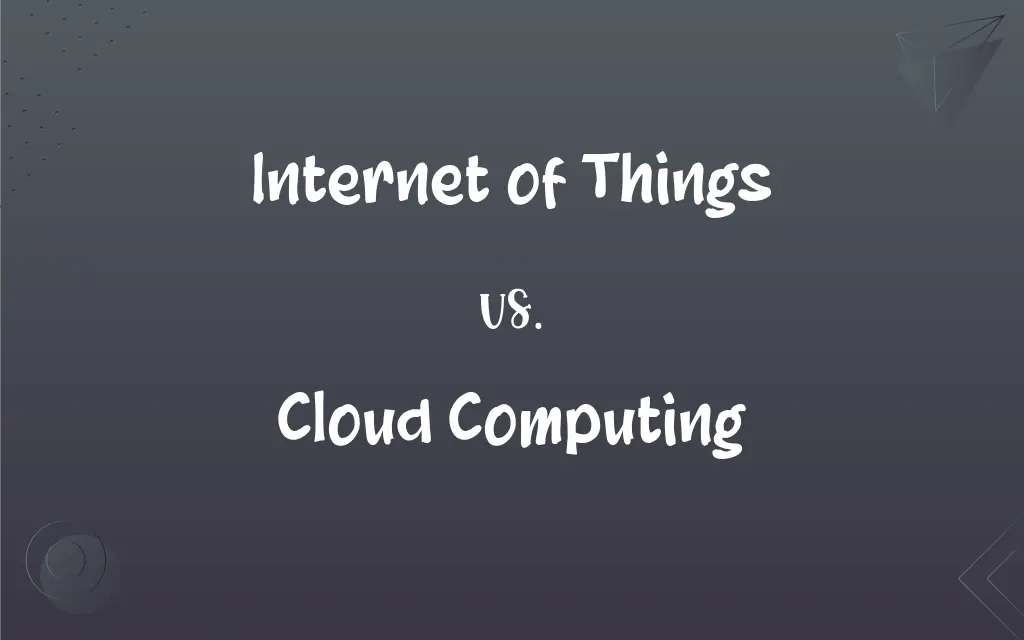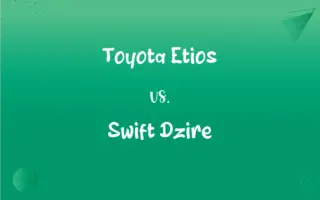Internet of Things vs. Cloud Computing: What's the Difference?
Edited by Aimie Carlson || By Janet White || Published on February 20, 2024
Internet of Things (IoT) involves connecting physical devices to the internet, whereas Cloud Computing provides virtual resources online for data storage and processing.

Key Differences
Internet of Things (IoT) refers to the network of physical objects embedded with sensors, software, and other technologies to connect and exchange data with other devices and systems over the internet. Cloud Computing, on the other hand, is the delivery of different services through the internet, including data storage, servers, databases, networking, and software. While IoT generates and collects data, Cloud Computing offers the infrastructure and processing power to store and analyze this data.
IoT devices range from ordinary household items to sophisticated industrial tools. They collect and transmit data, making physical objects part of the digital ecosystem. Cloud Computing, in contrast, relies on a network of remote servers hosted on the internet to manage, process, and store data, rather than local servers or personal computers. Thus, Cloud Computing provides the backbone for IoT by offering a platform for the storage and processing of data that IoT devices generate.
The primary focus of IoT is to bring internet connectivity to everyday objects, enhancing their functionality. It enables devices to communicate with each other and with user interfaces. Cloud Computing, however, is focused on maximizing the effectiveness of the shared data resources. It provides a scalable and flexible resource pool for storing and analyzing the vast amount of data generated by IoT devices.
IoT is often seen as the "front end," facing the user and collecting data in real-time, whereas Cloud Computing is the "back end," providing the computational power for data analysis. While IoT devices act as data gatherers in the field, Cloud Computing offers the analytical power to make sense of that data, often in real-time.
IoT brings additional value to physical devices through connectivity, while Cloud Computing offers a powerful infrastructure to process and store the data generated by these IoT devices. They are complementary technologies, with IoT providing the data and Cloud Computing offering the means to store and analyze it.
ADVERTISEMENT
Comparison Chart
Definition
Network of interconnected physical devices with internet capability.
Provision of computing services over the internet.
Primary Function
Data collection and transmission from physical devices.
Data storage, processing, and management services.
Focus Area
Enhancing functionality of physical objects through connectivity.
Providing virtual computing resources.
Data Processing
Collects and sends data for analysis.
Analyzes and processes data collected from various sources.
End-User Interaction
Direct interaction through smart devices and sensors.
Indirect interaction through service provision over the internet.
ADVERTISEMENT
Internet of Things and Cloud Computing Definitions
Internet of Things
Interconnected network of physical devices with internet capability.
Smart thermostats in homes adjust temperature based on user behavior, demonstrating the Internet of Things.
Cloud Computing
Providing shared computing resources, software, and information to devices on demand.
Streaming movies from an online service is an application of Cloud Computing.
Internet of Things
IoT extends internet connectivity beyond traditional devices to a wide range of physical devices and everyday objects.
Smart light bulbs controlled via a smartphone app exemplify the Internet of Things.
Cloud Computing
It allows for the accessing of data and programs over the internet instead of a computer's hard drive.
Editing a document in real-time with colleagues through a web-based application demonstrates Cloud Computing.
Internet of Things
Integration of digital technology into everyday objects, making them 'smart'.
A fitness tracker syncing data to a smartphone is an example of the Internet of Things.
Cloud Computing
Delivery of various computing services over the internet.
Storing personal photos on an online drive uses Cloud Computing.
Internet of Things
IoT involves enhancing physical devices with sensors and connectivity.
Internet-connected refrigerators that can order groceries are part of the Internet of Things.
Cloud Computing
Cloud Computing involves using remote servers on the internet to store, manage, and process data.
A business using online software for customer relationship management is leveraging Cloud Computing.
Internet of Things
A system where everyday objects are interconnected and exchange data.
Smart city sensors monitoring traffic flow represent the Internet of Things.
Cloud Computing
Cloud Computing offers scalable and flexible IT resources as services via the internet.
Companies scaling up their server capabilities instantly during high traffic periods exemplify Cloud Computing.
FAQs
Are IoT devices secure?
They can be vulnerable to security risks, hence need strong security measures.
Can IoT devices work without the internet?
They require internet connectivity to fully function and exchange data.
What are the benefits of Cloud Computing?
It offers cost efficiency, scalability, and accessibility from anywhere.
What industries benefit from IoT?
Healthcare, agriculture, manufacturing, and smart cities, among others.
How does IoT impact everyday life?
It makes everyday objects smarter and more efficient, enhancing user experience.
What is the Internet of Things?
It's a network of physical devices connected to the internet, exchanging data.
How does Cloud Computing differ from traditional computing?
It delivers computing services over the internet, offering flexibility and scalability.
How does Cloud Computing support IoT?
It provides the infrastructure for storing and processing data from IoT devices.
Can Cloud Computing be customized?
Yes, it offers customizable solutions to meet diverse needs.
How does Cloud Computing handle data loss?
It often includes backup and recovery solutions to mitigate data loss.
What are the challenges of Cloud Computing?
Security, privacy, and data management are major challenges.
What is the future of IoT?
Increased integration, more advanced AI capabilities, and wider adoption.
Is Cloud Computing environmentally friendly?
It can be, due to more efficient resource utilization and reduced physical infrastructure.
What skills are needed for Cloud Computing?
Skills in networking, database management, and cybersecurity are valuable.
How does IoT benefit businesses?
It offers enhanced data collection, efficiency, and customer engagement.
Can IoT work with legacy systems?
It can, but may require additional integration efforts.
What is a smart home?
A home equipped with IoT devices for automation and improved functionality.
Are there privacy concerns with IoT?
Yes, especially around data collection and handling.
What trends are emerging in Cloud Computing?
Trends include hybrid cloud solutions, AI integration, and edge computing.
Can Cloud Computing work offline?
Some functionalities can be limited or unavailable offline.
About Author
Written by
Janet WhiteJanet White has been an esteemed writer and blogger for Difference Wiki. Holding a Master's degree in Science and Medical Journalism from the prestigious Boston University, she has consistently demonstrated her expertise and passion for her field. When she's not immersed in her work, Janet relishes her time exercising, delving into a good book, and cherishing moments with friends and family.
Edited by
Aimie CarlsonAimie Carlson, holding a master's degree in English literature, is a fervent English language enthusiast. She lends her writing talents to Difference Wiki, a prominent website that specializes in comparisons, offering readers insightful analyses that both captivate and inform.































































